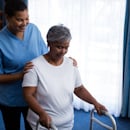
Safety Counts: Keeping on Top of Nurse Staffing and Fatigue
The Registered Nurse Safe Staffing Act H.R. 1821/S. 2353 requires that Medicare-participating hospitals implement staffing plans for each nursing unit and shift. The act requires the committee in charge of staffing to be comprised of direct-care nurses by at least 55%, and that staffing considerations include each unit’s unique characteristics and needs (ANA, 2015).
The Act also establishes adjustable minimum numbers of RNs for each unit, ensuring that staffing plans are based upon patient numbers and the patient acuity, as well as the level of education, training and experience of the RNs and support staff. A provision of the Act ensures that staffing levels are in compliance with recommendations by specialty nursing organizations, and requires healthcare organizations to avoid assigning RNs to units on which they are not trained or experienced. The bill also includes compliance provisions that require reporting of staffing information and data that can be used to establish a link between nurse staffing and patient acuity (ANA, 2015).
How Nurse Shortage Affects Patient Health
In addition to inadequate staffing levels, nurse fatigue appears to play a major role in patient safety. According to a 2013 survey commissioned by Kronos Inc., nurse fatigue is “pervasive” in the healthcare industry and can be directly related to errors and poor quality care (Ray-Ghosal, 2013). In the study, many nurses were concerned about their ability to perform safely, with two-thirds of RNs reporting that they had nearly made a mistake at work due to fatigue; more than a quarter admitted to having made a fatigue-related error (Bird, 2013).
Released in March 2013 at the American Organization of Nurse Executives (AONE) Conference in Denver, the "Nurse Staffing Strategy," pointed out that nurse fatigue not only negatively affects operational costs, but patient and employee satisfaction as well. According to the research findings, more than half of the nurses involved in the study (54%), felt they had an excessive workload and 96% reported being tired at the beginning of their shift. An astounding 65% said that their hospitals do not have policies regarding cumulative days of extended shifts (Bird, 2013). Separate research published in The Journal of the American Medical Association (JAMA) found that nurse understaffing in neonatal intensive care units (NICU) leads to higher infection rates among very low-birth-weight babies (Bird, 2013).
As patient advocates, nurses have a responsibility to ensure that their patient load is realistic, manageable and most importantly, safe for the patients. Nurses also have a responsibility to ensure that their fatigue is recognized and addressed before it becomes a safety concern.
To learn how to better advocate for yourself, check out the two-part series from RN.com entitled: Advocating for Yourself & Your Patients.
References
- American Nurses Association [ANA], (2015). Safe Staffing. Retrieved from here.
- Bird, J. (2013, March 21). Survey: Nurse understaffing, and fatigue threatens patient safety. FierceHealthcare.com. Retrieved from here.
- Clarke, S. P. & Donaldson, N. E. (2008). Nurse Staffing and Patient Care Quality and Safety. In Patient Safety and Quality: An Evidence-Based Handbook for Nurses (Chapter 25). Retrieved from here.
- Ray-Ghosal, I. (2013, March 20). Kronos survey reveals nurse fatigue is pervasive in the healthcare industry and directly linked to on-the-job errors. Kronos.com. Retrieved from here.
© 2015. AMN Healthcare, Inc. All Rights Reserved.




